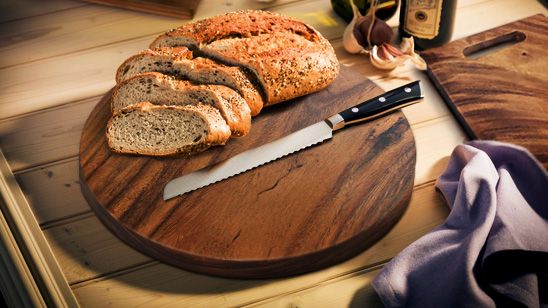
Benefits of Acacia Wood Cutting Boards and Dinnerware
Choosing the right material for your kitchenware is crucial. It impacts not only the aesthetics of your kitchen but also the longevity and functionality of the tools you use daily.
Acacia wood has emerged as a popular choice for cutting boards and dinnerware. Its natural beauty and durability make it a standout among other materials.
But what makes acacia wood so special? Why is it preferred by many home cooks and professional chefs alike?
In this article, we delve into the benefits of acacia wood for cutting boards and dinnerware. We'll explore its properties, compare it with other materials, and provide practical advice on its maintenance and care.
Whether you're considering a new cutting board or looking to upgrade your dinnerware, this guide will help you make an informed decision.
Browse our wide range of Acacia Wood Cutting Boards and Dinnerware here.
Understanding Acacia Wood and Its Properties
Acacia wood is a type of hardwood known for its durability and longevity. It's a dense wood, which makes it resistant to water and moisture. This property is crucial for kitchenware that often comes into contact with liquids.
The wood also boasts a naturally rich colour and an attractive grain pattern. These aesthetic qualities make acacia wood products not only functional but also visually appealing.
Here are some key properties of acacia wood:
- Durability and longevity
- Resistance to water and moisture
- Natural antibacterial properties
- Rich colour and attractive grain pattern
- Less prone to scratches and knife marks
These properties make acacia wood an excellent choice for cutting boards and dinnerware.
Acacia Wood in Comparison to Other Materials
When choosing kitchenware, it's important to compare different materials. Each material has its own set of advantages and disadvantages. Let's see how acacia wood stacks up against other common materials used for cutting boards and dinnerware.
Bamboo vs. Acacia Wood Cutting Boards
Bamboo is another popular choice for cutting boards. It's eco-friendly and relatively hard. However, acacia wood is denser and more durable than bamboo. This means acacia cutting boards are less likely to warp or crack over time.
Moreover, acacia wood has a richer colour and more attractive grain pattern. This gives acacia cutting boards a more premium look compared to bamboo ones.
Wood vs. Plastic Cutting Boards
Plastic cutting boards are lightweight and easy to clean. However, they can harbor bacteria in the knife grooves over time. Acacia wood, on the other hand, has natural antibacterial properties. This makes acacia cutting boards a more hygienic choice.
Furthermore, unlike plastic, acacia wood does not contain harmful chemicals that can leach into food. It's also more eco-friendly, as wood is a renewable resource.
Best Woods for Cutting Boards: Acacia's Place
There are many types of wood used for cutting boards, such as maple, walnut, and cherry. Each has its own unique properties. However, acacia wood stands out for its combination of durability, beauty, and affordability.
Acacia wood is hard and dense, which helps maintain the sharpness of cutting knives. It's also less likely to warp or crack with proper care. Plus, its rich colour and attractive grain pattern make it a visually appealing choice.
In conclusion, acacia wood holds its own against other popular materials for cutting boards and dinnerware. Its unique properties make it a practical and aesthetically pleasing choice.
The Hygienic Benefits of Acacia Wood
One of the key benefits of acacia wood is its natural antibacterial properties. This makes it a hygienic choice for cutting boards and dinnerware. The dense structure of acacia wood makes it less likely to harbour bacteria compared to softer woods.
Here are some hygienic benefits of acacia wood:
- Natural antibacterial properties
- Less prone to scratches and knife marks
- Resistance to stains and odours
- Easy to clean and disinfect
These properties make acacia wood a safe and healthy choice for your kitchen.
Does Bacteria Grow on Wood Cutting Boards?
A common concern with wood cutting boards is the potential for bacteria growth. However, studies have shown that bacteria are less likely to survive on wood surfaces compared to plastic. This is due to the antibacterial properties of wood.
In the case of acacia wood, its dense structure prevents deep grooves where bacteria can thrive. This makes acacia cutting boards a hygienic choice for food preparation.
How to Sanitize and Disinfect Acacia Wood
Cleaning acacia wood is straightforward. Simply wash it with warm soapy water and dry it immediately. Avoid soaking it in water to prevent swelling and cracking.
For disinfecting, you can use a solution of one part vinegar to five parts water. Wipe the surface with this solution, then rinse and dry. Regular cleaning and disinfecting will keep your acacia wood cutting boards and dinnerware in top condition.
Maintenance: Protecting and Restoring Acacia Wood
Proper maintenance is key to preserving the beauty and functionality of acacia wood. This involves regular cleaning, oiling, and avoiding practices that can damage the wood. Here are some tips for maintaining acacia wood:
- Clean immediately after use
- Oil regularly with food-grade mineral oil
- Avoid soaking in water
- Do not put in the dishwasher
- Store in a cool, dry place
With these practices, your acacia wood cutting boards and dinnerware can last for many years.
How to Protect Wood Cutting Boards
Protecting your acacia wood cutting board involves regular oiling. This enhances the wood's natural beauty and provides a protective barrier against stains and odours. Use food-grade mineral oil and apply it with a soft cloth.
Avoid using your acacia wood cutting board for heavy-duty tasks like chopping bones. This can cause deep scratches and damage the wood.
Cleaning and Caring for Your Acacia Wood
Cleaning acacia wood is simple. Wash it with warm soapy water and dry it immediately. Avoid using harsh chemicals as they can strip the wood's natural oils.
For stubborn stains, you can use a paste of baking soda and water. Apply the paste, let it sit for a few minutes, then rinse and dry.
Restoring and Sealing Acacia Wood
Over time, acacia wood may show signs of wear. But don't worry, it can be restored to its original condition. Sand the surface lightly to remove any scratches or stains. Then, apply a generous amount of food-grade mineral oil to seal the wood and restore its lustre.
The Aesthetic and Practical Advantages of Acacia Wood
Acacia wood is not just practical, it's also aesthetically pleasing. Its rich colour and attractive grain pattern can add a touch of elegance to any kitchen. Here are some of the aesthetic and practical advantages of acacia wood:
- Naturally rich colour and attractive grain pattern
- Can double as elegant serving platters
- Each piece is unique due to natural variations
- Adds a warm, organic touch to any meal
- Can elevate the aesthetic of any kitchen
Acacia Wood as a Design Element in Your Kitchen
Acacia wood can be a focal point in kitchen design. Its striking appearance and natural lustre can complement a variety of kitchen decors. Whether you have a modern, rustic, or traditional kitchen, acacia wood can fit right in.
Moreover, acacia wood's natural variations in colour and grain make each piece one-of-a-kind. This means your acacia wood cutting boards and dinnerware are not just functional kitchen tools, but also unique pieces of art.
Acacia Wood for Serving and Presentation
Acacia wood's beauty extends beyond its use as a cutting board. It can also double as an elegant serving platter. Whether you're serving cheese, charcuterie, or freshly baked bread, acacia wood can make your food look even more appetizing.
In addition, acacia dinnerware adds a warm, organic touch to any meal. It's perfect for both casual family dinners and formal gatherings. With acacia wood, you can serve your meals in style.
Sustainability and Environmental Impact of Acacia Wood
Acacia wood is not only durable and beautiful, but it's also eco-friendly. Here are some reasons why acacia wood is a sustainable choice:
- Acacia is a renewable resource, often harvested from managed forests.
- The wood's fast growth rate enhances its eco-friendliness.
- Acacia wood can be recycled or composted at the end of its life cycle.
- Its carbon footprint is lower compared to plastics and other non-renewable materials.
Acacia is a fast-growing tree, which means it can be harvested sustainably. Many acacia wood products come from managed forests where trees are replanted to replace those that are cut down. This ensures a continuous supply of wood without depleting the forest.
Moreover, at the end of its life cycle, acacia wood can be recycled or composted. This reduces waste and contributes to a circular economy. Unlike plastic, which can take hundreds of years to decompose, acacia wood breaks down naturally.
Finally, the production of acacia wood products has a lower carbon footprint compared to non-renewable materials like plastic. This makes acacia wood a more environmentally friendly choice for your kitchen.
Conclusion: Why Choose Acacia Wood for Your Kitchen
Choosing acacia wood for your cutting boards and dinnerware is a decision that combines aesthetics, functionality, and sustainability. Its natural beauty, durability, and hygienic properties make it a top choice for both casual cooks and professional chefs.
Moreover, acacia wood's eco-friendliness aligns with the growing trend of sustainable living. By choosing acacia, you're not only investing in high-quality kitchenware but also contributing to the preservation of our environment. In conclusion, acacia wood offers a blend of benefits that make it a standout choice for your kitchen.
